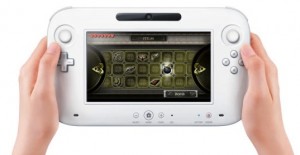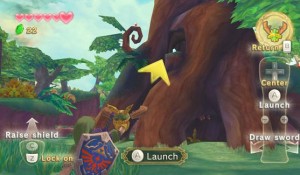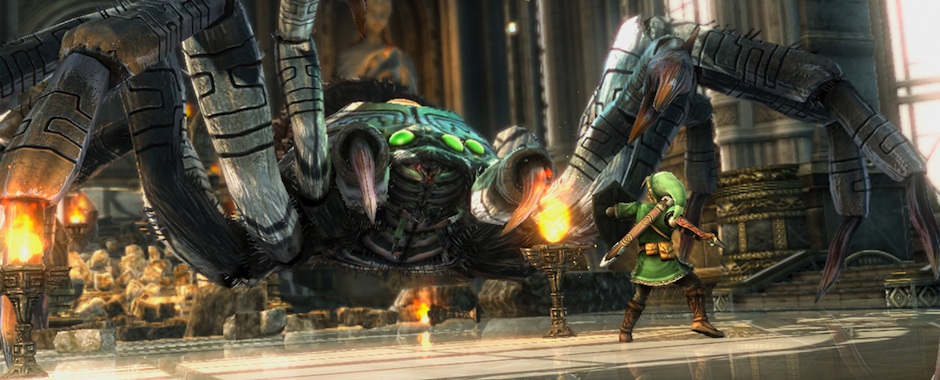With the Wii U being the most recent Nintendo Console to enter our homes, we’re hoping (as we assume others are) that the Legend of Zelda on Wii U is the best yet. We know it is in development already, but of course, at this early stage in the console’s lifecycle, as well as the fact that we got a new Zelda title just over a year ago, we haven’t heard anything about it yet. When we first saw the Wii U, we couldn’t help but feel that Nintendo would try to evolve previous Legend of Zelda games into tablet-based games that would make gameplay a gimmick. We then saw the Wii U Zelda demo at E3 2011 and thought differently; of course they’ll try something different, but maybe it won’t ruin the game.
 Let’s think of The Legend of Zelda gameplay from the tablet perspective. There are lots of ways the GamePad can improve gameplay but even more that could make it too much of a gimmick. In that same E3 demo (Nintendo called them “experiences”), we saw an in-depth view of Link’s surroundings with no HUD or equipment menu on the television. Instead, these controls were relegated to the GamePad to provide a much cleaner experience. Imagine the graphical and fresh experience having no heads-up display would create; something extremely immersive, especially in boss battles.
Let’s think of The Legend of Zelda gameplay from the tablet perspective. There are lots of ways the GamePad can improve gameplay but even more that could make it too much of a gimmick. In that same E3 demo (Nintendo called them “experiences”), we saw an in-depth view of Link’s surroundings with no HUD or equipment menu on the television. Instead, these controls were relegated to the GamePad to provide a much cleaner experience. Imagine the graphical and fresh experience having no heads-up display would create; something extremely immersive, especially in boss battles.
GamePad features aren’t all good news though.
Yes, the GamePad has a camera, something most other electronic devices advertise as if it makes the device what it is. Nintendo isn’t about to let the design of one of their most iconic characters change on a whim by using facial recognition to superimpose your face on Link’s body or anything, but that’s not to say that Nintendo can’t implement the camera in a way that creates a new puzzle solving mechanic.
Implementing the touchscreen itself properly is extremely important to a game like this. We’re hoping and praying that the touchscreen doesn’t become the de facto method for swinging the sword. We rather liked Skyward Sword‘s controls, and changing those now would take a lot of convincing. It might be interesting to see some magic-oriented gameplay implemented via the touchscreen, however, such as drawing shapes to cast spells. The touchscreen could also be used for items like the Beetle from Skyward Sword. You might be able to draw a path on the screen for the Beetle to fly to collect items, unlock doors, or toggle switches. Instruments have always played a large role in Zelda titles, and the touchscreen could be used for everything from selecting notes to getting timing right to strumming virtual strings. Then, there’s the more obvious use for the touchscreen: as a puzzle-solving mechanic. You might hop into the GamePad for a close-up view of a puzzle next to a dungeon door, for example, and slide blocks to make unlock the door.
 There are probably few ways to implement the GamePad’s microphone into gameplay. We’re positive Nintendo won’t use it for voice control gestures or anything so absurd (hey, Link can’t even talk!), but you could theoretically use it for humming a tune, we suppose. We’re kind of hoping that Nintendo forgets about the microphone completely, but if they can pull something awesome off, we’re all for it. We suppose it could be an optional control method if you’re obsessed with gimmicks in games.
There are probably few ways to implement the GamePad’s microphone into gameplay. We’re positive Nintendo won’t use it for voice control gestures or anything so absurd (hey, Link can’t even talk!), but you could theoretically use it for humming a tune, we suppose. We’re kind of hoping that Nintendo forgets about the microphone completely, but if they can pull something awesome off, we’re all for it. We suppose it could be an optional control method if you’re obsessed with gimmicks in games.
There are many ways Nintendo might implement the accelerometer and gyroscope in the GamePad into the next Zelda title. It could be used for sliding down steep slopes in some areas (no quicktime events, please), puzzle solving, shield-play, and shaking dust off those crusty old artifacts Link is always digging up. The accelerometer could also be used for making Link jump in the game, though this would probably be far more cumbersome than it would be effective.
The Legend of Zelda has never been a franchise shy of making changes in the name of evolving gameplay. Nintendo has always done an incredible job of innovating with their biggest franchises and taking risks as to what works with their most beloved characters. We’re absolutely certain that Zelda on Wii U will be no different. Many of these gameplay paradigms have been included in past Zelda games, but never with these implementations. There is nothing new in the puzzle-solving realm, but with the GamePad’s camera, touchscreen, and accelerometer, we could be seeing all-new puzzle design and solving mechanics we just haven’t seen before. They might be a risk to add, sure, but they’re necessary for the evolution of the The Legend of Zelda franchise. Don’t forget, one of the biggest reasons we loved Skyward Sword was its new additions and changes to the formula.
Here’s hoping we get a new Zelda title at E3 2013 this year. If we do, our money is on an original portable title for the 3DS (as well as perhaps a Majora’s Mask remake), but we’re pretty certain Wii U’s Zelda is on its way, too.
Theo Breheny contributed to this article.

